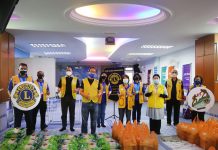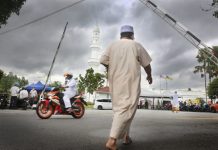
Isabella Bird was most likely the first female travel blogger and photographer to come to Seremban, Negeri Sembilan, that is not in doubt, but just who was Isabella Bird and what the heck was she doing in Seremban or as it was known back then in 1880, ‘Linggi, Serembang or Sungai Ujong?’
So just who was Isabella Bird?
Isabella was born in 1831 in the UK and by the time she died in 1904 she was regarded as an explorer, writer, naturalist, sketch artist and photographer, and at the height of her notoriety she was mentioned in the same breath as Queen Victoria and Florence Nightingale in regards the impact she had on society, mainly as a tirelessly advocate for the empowerment of women.

Isabella was given the honour of being the first female fellow in the auspicious Royal Geographical Society although at the time in the UK, not everyone agreed.
Lord Curzon, soon to be made the Viceroy of India, made his views clear in a letter to The Times, 30 May 1893.
“We contest in to the general capability of women to contribute to scientific geographical knowledge. Their sex and training render them equally unfitted for exploration, and the general professional female globe-trotters with which America has lately familiarised us is one of the horrors of the latter end of the 19th century.”
The Lord obviously hadn’t read her letters or books that simply overflow and explode with incredible research, description, observations and storytelling from this female ‘tour de force.’
Isabella first began travelling to “alleviate” some poor health issues, caught the travel bug and didn’t stop until her death at the age of 72. After returning from a trip to Morocco she fell ill, but always the optimist, her travel bags and photography kit were packed and ready to go, but it was not to be.
Isabella’s other travels included America, New Zealand, Hawaii, Australia, India, Kurdistan, the Persian Gulf, Iran, Tibet, Malaysia, Korea, Japan and China to name some.

Her most famous book, written in 1873, is named ‘A Lady’s Life in the Rocky Mountains’ in which she met Jim Nugent, who was described by others as Rocky Mountain Jim, an outlaw with one eye, (a fight with a bear disfigured half his face) who had an affinity for violence and poetry.
Isabella consistently wrote to her sister, who helped and advised on printing her escapades and said that Jim was “a man any woman might love but no sane woman would marry.”
She also wrote a wonderful character description of him, illustrating her mastery of writing, as well as showing she may well have had a big crush on a man who asked her to marry him.
“He has pathos, poetry, and humour, an intense love of nature, strong vanity in certain directions, an obvious desire to act and speak in character, and sustain his reputation as a desperado, a considerable acquaintance with literature, a wonderful verbal memory, opinions on every person and subject, a chivalrous respect for women in his manner, which makes it all the more amusing when he suddenly turns round upon one with some graceful raillery, a great power of fascination, and a singular love of children. The children of this house run to him, and when he sits down they climb on his broad shoulders and play with his curls…one eye was entirely gone, and the loss made one side of his face repulsive, while the other may have been modelled in marble. ‘Desperado’ was written in large letters all over him,” she wrote.
Less than ten years later in 1880, Isabella, with letters of introduction to the elite of Malacca and Penang, arrived on the Malay Peninsular or as it was dubbed in those days, “The Golden Chersonese.”
She wrote more than120,000 words in her letters to her sister and in her diaries during the one month she was in Malaysia and you can access them, and The Golden Chersonese and the Way Thither, via the link below.
Her descriptions of cultures, religions and life in the area are vivid, abrupt at times but entertaining and amusing as well. It’s a good read if you are up for the length and depth of her descriptions.
Isabella’s journey in Malaysia was one of many contrasts, beginning in the luxury and grandeur that is Malacca’s Stadthuys and from there went very quickly to sleeping in a less than luxurious Malayan stilt village in the jungle the next evening.

One letter describes the departure as thus: Jan.24. 1 P.M. Mercury, 87°.
“We left Malacca at seven this morning in the small, unseaworthy, untrustworthy, unrigged steam-launch Moosmee, and after crawling for some hours at a speed of about five miles an hour along brown and yellow shores with a broad, dark belt of paexplorer, seremban, traveller, photographer, travel blogger, isabella, negeri sembilanlms above them, we left the waveless, burning sea behind, and after a few miles of tortuous steaming through the mangrove swamps of the Linggi river, landed here to wait for sufficient water for the rest of our journey.
“The mangrove swamp is to me an evil mystery. Soon after we sat down to drink fresh ‘cocoa-nut milk’, the great beverage of the country, a Malay bounded up the ladder and passed through us, with the most rapid and feline movements I have ever seen in a man. His large prominent eyes were fixed, tiger-like, on a rifle which hung on the wall, at which he darted, clutched it, and, with a feline leap, sprang through us again. I have heard much of amok running lately, and have even seen the two-pronged fork which was used for pinning a desperate amok runner to the wall, so that for a second I thought that this Malay was “running amuck;” but he ran down toward Mr. Hayward, our escort, and I ran after him, just in time to see a large alligator plunge from the bank into the water. Mr. Hayward took a steady aim at the remaining one, and hit him, when he sprang partly up as if badly wounded, and then plunged into the river after his companion, staining the muddy water with his blood for some distance.”
Now that’s travel blogging.

Her journey up river to “Serembang” as it was known as back then, through the state of Negeri Sembilan is hilarious as she describes every minute detail that you could imagine, from plants and animals to recent and old statistics of government, to chiding the governor’s daughters travelling with her and amazement at the feats her cook Babu, achieved along the way.
The book is really very funny and mind blowing in the amount of detail she took in and wrote about including taxes, population and behavioural observations.
Not only was her writing first class but she also sketched all these drawings in the chapter/book along the way, as she had not yet learnt photography, which was soon to come later on during her China trips. (see link below for some of her photography)
Isabella Photography – TheGuardian
Although she writes that “the “Golden Chersonese” is very hot, and much infested by things which bite and sting,” she also wrote whilst travelling in Negeri Sembilan, “Mr. (Charles) Darwin says so truly that a visit to the tropics is like a visit to a new planet. This new wonder-world, so enchanting, tantalising, intoxicating, makes me despair, for I cannot make you see what I am seeing!
Isabella spent four days in “Serembang” and was delighted with her host Captain Murray, British Resident in the State of Sungei Ujong.
“He devotes himself to Sungei Ujong as if it were his own property, though he has never been able to acquire the language. He is a man about thirty-eight, a naval officer, and an enterprising African traveler; under the middle height, bronzed, sun- browned, disconnected in his conversation from the habit of living without any one in or out of the house to speak to; professing a misanthropy which he is very far from feeling, for he is quite unsuspicious, and disposed to think the best of every one; hasty when vexed, but thoroughly kind-hearted; very blunt, very undignified, never happy (he says) out of the wilds; thoroughly well disposed to the Chinese and Malays, but very impatient of their courtesies, thoroughly well meaning, thoroughly a gentleman. He is a thoroughly honourable man, means well by all the interests of his little kingdom, and seems both beloved and trusted.”
Isabella wrote about so many things it is impossible to convey all of it in one story; taxes, wages, religious and cultural observations as well as food and business were all thrown into her chapters, in extraordinary detail.
‘Serembang’ (Seremban)was a very different place back then as it is now. This was a period when opium selling was the second largest import just behind rice supplies. The population
“The population of this tiny State, which in 1832 consisted of three thousand two hundred Malays and four hundred Chinese, at the time of my visit had risen to twelve thousand, composed of three Europeans, a few Klings, two thousand Malays, and ten thousand Chinese. It exports tin in large quantities, gutta-percha collected in the interior by the aborigines, coffee, which promises to become an important production, buffalo hides, gum dammar, and gharroo. In 1879 the exports amounted to £81,976; £81,451 being the value of tin. Its imports are little more than half this amount. Rice heads the list with an import of £18,150 worth, and opium comes next, valued at £14,448.”
The Golden Chersonese and the Way Thither is a wonderful read full of portraits of people, places, religions and culture, written by an intriguing woman who had no qualms about telling it how she saw it and how she felt it.
You can read the entire book, or just the chapters on Negeri Sembilan, on a digital format by clicking on this link below.







































